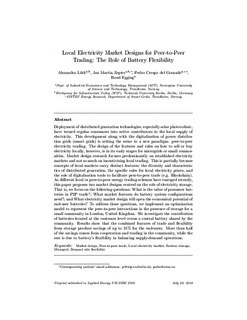| dc.contributor.author | Alexandra, Lueth | |
| dc.contributor.author | Jan, Zepter | |
| dc.contributor.author | Crespo del Granado, Pedro | |
| dc.contributor.author | Egging, Ruud | |
| dc.date.accessioned | 2019-03-18T13:39:21Z | |
| dc.date.available | 2019-03-18T13:39:21Z | |
| dc.date.created | 2018-11-06T14:14:04Z | |
| dc.date.issued | 2018 | |
| dc.identifier.issn | 0306-2619 | |
| dc.identifier.uri | http://hdl.handle.net/11250/2590508 | |
| dc.description.abstract | Deployment of distributed generation technologies, especially solar photovoltaic, have turned regular consumers into active contributors to the local supply of electricity. This development along with the digitalisation of power distribution grids (smart grids) is setting the scene to a new paradigm: peer-to-peer electricity trading. The design of the features and rules on how to sell or buy electricity locally, however, is in its early stages for microgrids or small communities. Market design research focuses predominantly on established electricity markets and not so much on incentivising local trading. This is partially because concepts of local markets carry distinct features: the diversity and characteristics of distributed generation, the specific rules for local electricity prices, and the role of digitalisation tools to facilitate peer-to-peer trade (e.g. Blockchain). As different local or peer-to-peer energy trading schemes have emerged recently, this paper proposes two market designs centred on the role of electricity storage. That is, we focus on the following questions: What is the value of prosumer batteries in P2P trade?; What market features do battery system configurations need?; and What electricity market design will open the economical potential of end-user batteries? To address these questions, we implement an optimisation model to represent the peer-to-peer interactions in the presence of storage for a small community in London, United Kingdom. We investigate the contribution of batteries located at the customer level versus a central battery shared by the community. Results show that the combined features of trade and flexibility from storage produce savings of up to 31% for the end-users. More than half of the savings comes from cooperation and trading in the community, while the rest is due to battery’s flexibility in balancing supplydemand operations. | nb_NO |
| dc.language.iso | eng | nb_NO |
| dc.publisher | Elsevier | nb_NO |
| dc.rights | Attribution-NonCommercial-NoDerivatives 4.0 Internasjonal | * |
| dc.rights.uri | http://creativecommons.org/licenses/by-nc-nd/4.0/deed.no | * |
| dc.title | Local electricity market designs for peer-to-peer trading: the role of battery flexibility | nb_NO |
| dc.title.alternative | Local electricity market designs for peer-to-peer trading: the role of battery flexibility. | nb_NO |
| dc.type | Journal article | nb_NO |
| dc.type | Peer reviewed | nb_NO |
| dc.description.version | acceptedVersion | nb_NO |
| dc.source.volume | 229 | nb_NO |
| dc.source.journal | Applied Energy | nb_NO |
| dc.identifier.doi | 10.1016/j.apenergy.2018.08.004 | |
| dc.identifier.cristin | 1627563 | |
| dc.relation.project | Norges forskningsråd: 209697 | nb_NO |
| dc.relation.project | EC/H2020/691843 | nb_NO |
| dc.description.localcode | © 2018. This is the authors’ accepted and refereed manuscript to the article. Locked until 30.8.2020 due to copyright restrictions. This manuscript version is made available under the CC-BY-NC-ND 4.0 license http://creativecommons.org/licenses/by-nc-nd/4.0/ | nb_NO |
| cristin.unitcode | 194,0,0,0 | |
| cristin.unitcode | 194,60,20,0 | |
| cristin.unitcode | 194,60,25,0 | |
| cristin.unitname | Norges teknisk-naturvitenskapelige universitet | |
| cristin.unitname | Institutt for samfunnsøkonomi | |
| cristin.unitname | Institutt for industriell økonomi og teknologiledelse | |
| cristin.ispublished | true | |
| cristin.fulltext | postprint | |
| cristin.qualitycode | 1 | |

